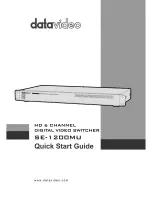
158
|
Interfaces
www.dell.com | support.dell.com
vlan tagged
Add a Layer 2 interface to a VLAN as a tagged interface.
Syntax
tagged
interface
To remove a tagged interface from a VLAN, use
no
tagged
interface
command.
Parameters
Defaults
All interfaces in Layer 2 mode are untagged.
Command Modes
INTERFACE VLAN
Command
History
Usage
Information
When you use the
no tagged
command, the interface is automatically placed in the default VLAN as
an untagged interface unless the interface is a member of another VLAN. If the interface belongs to
several VLANs, you must remove it from all VLANs to change it to an untagged interface.
Tagged interfaces can belong to multiple VLANs, while untagged interfaces can only belong to one
VLAN at a time.
When two or more ports configured for VLANs form a LAG, the resulting LAG is a tagged member of
all the configured VLANs and an untagged member of the VLAN to which the port with the lowest
port ID belongs.
For example, if port 0/33 is an untagged member of VLAN 2 and port 0/41 is an untagged member of
VLAN 3, the resulting LAG consisting of the two ports is an untagged member of VLAN 2 and a
tagged member of VLANs 2 and 3.
Example
Figure 11-34. VLAN Tagged Command Example
Related
Commands
interface
Enter the following keywords and slot/port or number information:
•
For a 10-Gigabit Ethernet interface, enter the keyword
TenGigabitEthernet
followed by the slot/port information.
Version 8.3.17.0
Supported on M I/O Aggregator
FTOS(conf-if-te-0/2)#vlan tagged ?
VLAN-RANGE Comma/Hyphen separated VLAN ID set
FTOS(conf-if-te-0/2)#vlan tagged 2,3-4
FTOS(conf-if-te-0/2)#show config
!
interface TenGigabitEthernet 0/2
mtu 12000
vlan tagged 2-4
!
port-channel-protocol LACP
port-channel 1 mode active
!
protocol lldp
advertise management-tlv system-name
dcbx port-role auto-downstream
no shutdown
FTOS(conf-if-te-0/2)#
interface vlan
Configures a VLAN.
vlan untagged
Specifies which interfaces in a VLAN are untagged.
Summary of Contents for PowerEdge M IO Aggregator
Page 14: ...12 Before You Start w w w d e l l c o m s u p p o r t d e l l c o m ...
Page 40: ...38 File Management w w w d e l l c o m s u p p o r t d e l l c o m ...
Page 80: ...78 Control and Monitoring w w w d e l l c o m s u p p o r t d e l l c o m ...
Page 90: ...88 u Boot w w w d e l l c o m s u p p o r t d e l l c o m ...
Page 108: ...106 Data Center Bridging w w w d e l l c o m s u p p o r t d e l l c o m ...
Page 114: ...112 Dynamic Host Configuration Protocol DHCP w w w d e l l c o m s u p p o r t d e l l c o m ...
Page 128: ...126 Internet Group Management Protocol IGMP w w w d e l l c o m s u p p o r t d e l l c o m ...
Page 162: ...160 Interfaces w w w d e l l c o m s u p p o r t d e l l c o m ...
Page 178: ...176 IPv4 Routing w w w d e l l c o m s u p p o r t d e l l c o m ...
Page 182: ...180 iSCSI Optimization w w w d e l l c o m s u p p o r t d e l l c o m ...
Page 186: ...184 Link Aggregation Control Protocol LACP w w w d e l l c o m s u p p o r t d e l l c o m ...
Page 190: ...188 Layer 2 w w w d e l l c o m s u p p o r t d e l l c o m ...
Page 210: ...208 Security w w w d e l l c o m s u p p o r t d e l l c o m ...
Page 246: ...244 Uplink Failure Detection UFD w w w d e l l c o m s u p p o r t d e l l c o m ...
Page 262: ...260 Debugging and Diagnostics w w w d e l l c o m s u p p o r t d e l l c o m ...
















































